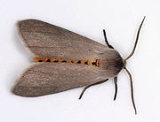
Euchaetes egle
Encyclopedia
Euchaetes egle, the milkweed tussock caterpillar or milkweed tiger moth, is a moth in the family Arctiidae
. It is a common mid to late-summer feeder on milkweeds and dogbane. Like most species in this family, it has chemical defenses it acquires from its host plants, in this case, cardiac glycoside
s (Weller et al., 1999). These are retained into the adult stage and deter bats, and presumably other predators, from feeding on them (Hristov and Conner 2005). Only very high cardiac glycoside concentrations deterred bats, however (Hristov and Conner 2005). Unpalatability is advertised with clicks from the tymbal organs (Simmons and Conner 1996).
Image:Euchaetes2.JPG | Early instar
Image:Euchaetes.JPG | Late instar
Image:Euchaetes_Egle_(Milkweed_Tussock_Caterpillar)_-_Late_Instar_-_Oct_2007_TX_-_JScottKelley.jpg | Late instar (Additional View)
Image:Euch_attack.JPG | under attack of pentatomid
These plants produce a sticky latex that can impede feeding. Early instars avoid the veins by skeletonizing the leaves. Older larvae sever the veins of the leaves that supply the latex, to reduce the flow to the area they feed on (Dussourd and Denno, 1991).
Arctiidae
Arctiidae is a large and diverse family of moths with around 11,000 species found all over the world, including 6,000 neotropical species. This family includes the groups commonly known as tiger moths , which usually have bright colours, footmen , lichen moths and wasp moths...
. It is a common mid to late-summer feeder on milkweeds and dogbane. Like most species in this family, it has chemical defenses it acquires from its host plants, in this case, cardiac glycoside
Cardiac glycoside
Cardiac glycosides are drugs used in the treatment of congestive heart failure and cardiac arrhythmia. These glycosides are found as secondary metabolites in several plants, but also in some animals, such as the milkweed butterflies. -Function:...
s (Weller et al., 1999). These are retained into the adult stage and deter bats, and presumably other predators, from feeding on them (Hristov and Conner 2005). Only very high cardiac glycoside concentrations deterred bats, however (Hristov and Conner 2005). Unpalatability is advertised with clicks from the tymbal organs (Simmons and Conner 1996).
Larva
Early instars appear slightly 'hairy' and gray. They skeletonize whole leaves gregariously, leaving a lacy remnant. They are gregarious until the third instar. Later instars sport tufts of black, white and orange (sometimes yellow) setae. The head capsule is black. The later instars wander much more, and may appear alone or in small clusters. Mature caterpillars are found from June onwards (Wagner 2005). Grows to a length of 35 mm.Image:Euchaetes2.JPG | Early instar
Image:Euchaetes.JPG | Late instar
Image:Euchaetes_Egle_(Milkweed_Tussock_Caterpillar)_-_Late_Instar_-_Oct_2007_TX_-_JScottKelley.jpg | Late instar (Additional View)
Image:Euch_attack.JPG | under attack of pentatomid
Pupa
The gray cocoon is 'felted,' presumably with 'hairs' from the larvae, and overwinters (Wagner, 2005).Adults
Wings are yellowish-white. The forewings have bands of beige edged in faint black across them. The body is 'hairy' and yellow, with a row of black dots down the middle of the back. Males use their tymbal organs in courtship, calling to the females, and in defense against bats (Simmons and Conner, 1996).Food plants
Milkweeds (Asclepias spp.) are the most common hosts, but it is also found on dogbane (Apocynum spp.). They often prefer older plants of milkweed, and seldom share plants with monarchs Danaus plexippus, which prefer younger plants (Wagner, 2005).These plants produce a sticky latex that can impede feeding. Early instars avoid the veins by skeletonizing the leaves. Older larvae sever the veins of the leaves that supply the latex, to reduce the flow to the area they feed on (Dussourd and Denno, 1991).

